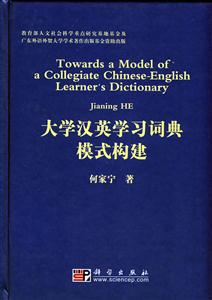-
>
鲍勃·迪伦诗歌集:1961-2012:典藏版
-
>
双城记-英文版
-
>
四级词汇词根+联想记忆法:乱序版
-
>
The secret garden
-
>
哈克贝利.费恩历险记/床头灯英语.2000词读物(英汉对照)
-
>
10000德语分类词汇联想记忆
-
>
英语词汇全书
大学汉英学习词典模式构建 版权信息
- ISBN:9787030217882
- 条形码:9787030217882 ; 978-7-03-021788-2
- 装帧:一般胶版纸
- 册数:暂无
- 重量:暂无
- 所属分类:>>
大学汉英学习词典模式构建 本书特色
《大学汉英学习词典模式构建》的主要目标是从词典使用者的视角构建一个大学汉英学习词典的模式。更详细的书名可以称为《基于使用者视角的大学汉英学习词典模式构建》。主要内容分为两大部分:词典使用研究和词典模式构建。前者是基础,后者是目标。
大学汉英学习词典模式构建 内容简介
目前还没有一部能与英汉(或英汉双解、英语单语)学习词典(如《牛津高阶英汉双解词典》)相媲美的汉英学习词典,因此有必要进行相关的基础研究,进而编写出一部适合中国英语学生的、高质量的汉英学习词典。
本书的主要目标是从词典使用者的视角构建一个大学汉英学习词典的模式。更详细的书名可以称为《基于使用者视角的大学汉英学习词典模式构建》。主要内容分为两大部分:词典使用研究和词典模式构建。前者是基础,后者是目标。
首先,从社会心理学和心理语言学两个角度对中国英语大学生在汉译英过程中使用词典的情况作了定量的实证研究。通过问卷调查、翻译测试和有声思维三种研究方法,采集了大量的数据。涉及社会心理方面的因素包括:学生拥有的词典、购买词典的动机、对词典的态度、词典使用说明的阅读、词典使用的频率、词典使用的满意度、改进词典的建议、词典使用技能的训练、对词典的期望。涉及心理语言学方面的因素包括:使用词典查询的目标词、使用的词典、使用词典的目的、查询词典的组件、运用词典信息的情况(译文表达式的来源、运用词典信息的方式、选择**义项的倾向以及词典信息运用的效果)。
其次,根据以上词典使用研究的发现,同时参考词典学的相关理论研究和实证研究,以现有的学生常用的汉英词典(《汉英词典》及《现代汉英词典》)为基础,构建了一个大学汉英学习词典的模式,提出了编写供中国大学生使用的大学汉英学习词典的十八条设计及编纂原则。总体原则涉及以需求为基础、以产品为属性的词典定位。具体原则涉及词典结构,包括总体结构(宏观结构和外在部分;外在部分又分为前面部分、中间部分和后面部分)、微观结构、中观结构、检索结构和分布结构。努力确保设计的词典不仅成为信息查询的工具,而且也是英语学习的工具。
本书适合词典学(尤其是词典使用和双语学习词典研究)研究者和词典编纂者阅读,对翻译学(尤其是翻译心理研究)和英语教育学(尤其是英语教育心理学)的研究者也具有一定的参考价值。
大学汉英学习词典模式构建 目录
Acknowledgments
内容提要
Abstract
Chapter Ⅰ Introduction
1.1 Research objective
1.2 Research rationale
1.2.1 Rationale for studying dictionary use in CET
1.2.2 Rationale for designing a CCELD
1.3 Research approach
1.4 Outline of the book
PART Ⅰ DICTIONARY USE STUDY
Chapter 2 Literature Review on Dictionary Use Study
2.1 Necessity of dictionary use study
2.1.1 Necessity of studying dictionary users
2.1.2 Necessity of studying dictionary use empirically
2.1.3 Summary
2.2 Research areas in dictionary use study
2.2.1 Hartmann's classification
2.2.2 Hulstijn & Atkins's classification
2.2.3 Tono's classification
2.2.4 Cowie's classification
2.2.5 Summary
2.3 Research questions
2.3.1 Wiegand's research questions
2.3.2 Hartmann's review of hypotheses about dictionary users
2.3.3 Summary
2.4 Theoretical framework
2.4.1 Nesi's model
2.4.2 Scholfield's model
2.4.3 Hartmann's model
2.4.4 Bogaards's model
2.4.5 Luo, Wang and Cao's model
2.4.6 Summary
2.5 Research methodology
2.5.1 Hartmann's classification
2.5.2 Tono's classification
2.5.3 Summary
2.6 Main findings of dictionary use studies
2.6.1 Dictionary ownership, preference and frequency of dictionary Use
2.6.2 Strategies in dictionary use
2.6.3 Factors affecting dictionary use
2.6.4 Degree of satisfaction with dictionary use
2.6.5 Effect of dictionary use
2.6.6 Training of dictionary use competence
2.6.7 Dictionary use in vocabulary acquisition
2.6.8 Studies on dictionary use in L1-L2 translation
2.7 Concluding remarks
Chapter 3 Sociopsychological Study on Dictionary Use
3.1 Research areas
3.2 Research questions
3.3 Theoretical framework
3.3.1 The model
3.3.2 The main factors
3.4 Research methodology: Questionnaire
3.4.1 Purpose
3.4.2 Participants
3.4.3 Material.
3.4.4 Procedure
3.5 Research findings and discussion
3.5.1 Ownership of dictionaries
3.5.2 Motivation to buy dictionaries
3.5.3 Attitude towards dictionaries
3.5.4 Guide-reading for using dictionaries
3.5.5 Frequency of using dictionaries
3.5.6 Satisfaction with the use of dictionaries
3.5.7 Training in dictionary use
3.5.8 Necessity of and expectations on a CCELD
3.6 Concluding remarks
Chapter 4 Psycholinguistic Study on Dictionary Use
4.1 'Research areas
4.2 Research questions: CET test
4.3 Research questions: Think-aloud protocol
4.4 Theoretical framework: Overview
4.5 Theoretical framework: A psycholinguistic model of CET
4.5.1 The model
4.5.2 Main components
4.5.3 Main procedures
4.6 Theoretical framework: A 15-sycholinguistic model of dictionary use in CET
4.6.1 The model
4.6.2 The main procedures
4.7 Research methodology: CET test
4.7.1 Purpose
4.7.2 Participants
4.7.3 Material
4.7.4 Procedure
4.8 Research methodology: Think-aloud protocol
4.8.1 Purpose
4.8.2 Participants
4.8.3 Material
4.8.4 Procedure
4.9 Research findings and discussions: CET test
4.9.1 Target lexical items for dictionary use
4.9.2 Dictionaries used
4.9.3 Purposes of dictionary use
4.9.4 Dictionary components consulted
4.9.5 Utilization of dictionary information
4.10 Research findings and discussions: Think-aloud protocol
4.10.1 Target lexical items for dictionary consultation
4.10.2 Dictionaries used
4.10.3 Purposes of dictionary use
4.10.4 Utilization of dictionary information
4.11 Concluding remarks
PART Ⅱ MODEL BUILDING
Chapter 5 Theoretical Basis
5.1 Dictionary typology
5.1.1 Hartmann's typology of pedagogical dictionaries
5.1.2 The type of CCELD
5.2 Dictionary structure
5.2.1 Overview
5.2.2 Megastructure
5.2.3 Microstructure
5.2.4 Mediostructure
5.2.5 Access structure
5.2.6 Distribution structure
5.3 Dictionary models
5.3.1 Yuan's CELD model
5.3.2 Laufer's 'bilingual dictionary plus' model
5.4 Concluding remarks
Chapter 6 Empirical Basis
6.1 Results on sociopsychological factors
6.2 Results on psycholinguistic factors
6.3 Concluding remarks
Chapter 7 Dictionary Basis
7.1 Target users, purposes and features
7.1.1 MCED (1988)
7.1.2 CED (1997)
7.2 Overall information
7.2.1 Table of contents
7.2.2 Basic information
7.3 Entry information
7.4 Concluding remarks
Chapter 8 A Model of a CCELD
8.1 Overview
8.2 General principles
8.3 Specific principles on the CCELD
8.3.1 Principles on megastructure of the CCELD
8.3.2 Principles on outside matter of the CCELD
8.3.3 Principles on front matter of the CCELD
8.3.4 Principles on middle matter of the CCELD
8.3.5 Principles on back matter of the CCELD
8.3.6 Principles on macrostructure of the CCELD
8.3.7 Principles on microstructure of the CCELD
8.3.8 Principles on mediostructure structure of the CCELD
8.3.9 Principles on access structure of the CCELD
8.3.10 Principles on distribution structure of the CCELD
8.4 Concluding remarks
Chapter 9 Conclusion
References
Appendix I Tools for Studying Dictionary Use in CET
Appendix II Raw Data of the Study by Think-aloud Protocol
Appendix III A Report on a Study on Dictionary Use in Vocabulary Acquisition
- >
推拿
推拿
¥12.2¥32.0 - >
随园食单
随园食单
¥20.6¥48.0 - >
新文学天穹两巨星--鲁迅与胡适/红烛学术丛书(红烛学术丛书)
新文学天穹两巨星--鲁迅与胡适/红烛学术丛书(红烛学术丛书)
¥11.0¥23.0 - >
二体千字文
二体千字文
¥16.0¥40.0 - >
月亮虎
月亮虎
¥17.8¥48.0 - >
我从未如此眷恋人间
我从未如此眷恋人间
¥16.4¥49.8 - >
伊索寓言-世界文学名著典藏-全译本
伊索寓言-世界文学名著典藏-全译本
¥6.1¥19.0 - >
罗庸西南联大授课录
罗庸西南联大授课录
¥13.8¥32.0
-
大学英语语法
¥30.7¥43.9 -
2022图书×抽奖盲袋
¥9.9¥25 -
2023读书月阅读盲盒——天黑,闭眼,刀谁?
¥42.3¥158 -
2022读者节纪念徽章-三星会员专属
¥45¥45.6 -
2023读书月阅读盲盒——我什么场面没见过?
¥42.3¥158
















